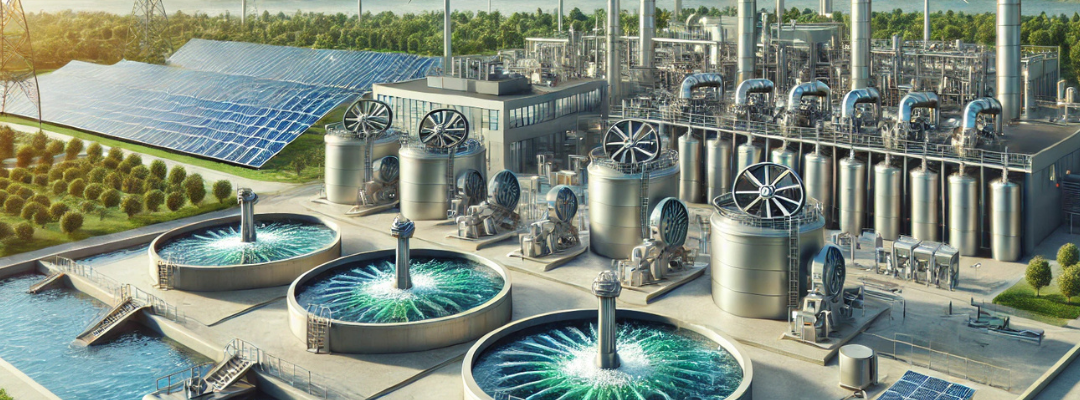Energy-efficient pumping solutions are critical for wastewater treatment plants (WWTPs), as pumps account for a significant portion of total energy consumption. Reducing energy use while maintaining operational efficiency is key to lowering costs, minimizing environmental impact, and ensuring the long-term sustainability of wastewater management.
Advancements in smart pumping technologies, optimized system design, and energy recovery methods are transforming wastewater treatment processes, leading to cost savings and enhanced reliability.
Key Pumping Applications in Wastewater Treatment
- Raw Sewage Inflow: Transporting raw sewage from collection networks to treatment facilities.
- Sludge Handling: Moving thickened sludge between treatment stages such as digestion, dewatering, and disposal.
- Aeration: Supplying air to biological treatment tanks to facilitate the breakdown of organic matter.
- Effluent Discharge: Pumping treated water into the environment or reuse applications.
Advanced Energy-Efficient Pumping Solutions
1. Variable Frequency Drives (VFDs)
How They Work:
VFDs regulate the speed of pump motors by adjusting voltage and frequency, allowing pumps to operate at variable speeds based on demand rather than running at full capacity continuously.
Key Benefits:
- Optimized Energy Use: Adjusts pump speed dynamically to match real-time flow requirements, reducing energy waste.
- Enhanced Pump Lifespan: Minimizes wear and tear by preventing unnecessary high-speed operation.
- Cost Savings: Reduces electricity consumption during low-demand periods, such as overnight or seasonal fluctuations.
WWTP Applications:
- Inflow and Effluent Pumps: Adjust pump speeds according to wastewater flow variations.
- Aeration Blowers: Optimize airflow based on real-time oxygen levels, preventing over-aeration and energy wastage.
2. High-Efficiency Motors (IE3/IE4 Rated)
How They Work:
High-efficiency motors use advanced materials, precision engineering, and superior cooling systems to reduce energy losses.
Key Benefits:
- Lower Operating Costs: Consumes less power than traditional motors, resulting in substantial long-term savings.
- Improved Performance: Higher power factor and reduced heat loss improve operational efficiency.
- Sustainability Compliance: Meets or exceeds global efficiency standards like NEMA Premium and IE3/IE4
WWTP Applications:
- Sludge Handling Pumps: Ideal for energy-intensive sludge processing applications.
- Effluent Discharge Pumps: Enhances efficiency in post-treatment water transfer systems.
3. Smart Pumping Solutions with IoT & AI Integration
How They Work:
IoT-enabled smart pumps use real-time sensors, predictive analytics, and automation to optimize performance and minimize energy consumption.
Key Benefits:
- Data-Driven Decision Making: Monitors pump performance, flow rates, and energy use to adjust operations dynamically.
- Predictive Maintenance: Detects early signs of wear, reducing downtime and maintenance costs.
- Remote Monitoring: Enables plant operators to control and adjust pumps remotely, improving efficiency.
WWTP Applications:
- Aeration Systems: Smart pumps optimize airflow delivery to match actual oxygen demand.
- Sludge Management: Automates sludge transfer processes, ensuring efficient operation.
4. Optimized Pump Selection and Sizing
How It Works:
Selecting the right pump ensures optimal performance and prevents energy waste due to oversizing or undersizing.
Key Benefits:
- Efficiency Optimization: Properly sized pumps operate at peak efficiency, reducing unnecessary energy use.
- Reduced Maintenance Costs: Avoids overworking pumps, minimizing mechanical failures.
- Longer Equipment Lifespan: Enhances operational durability by running pumps within their best efficiency point (BEP).
WWTP Applications:
- Raw Sewage Pumps: Custom sizing prevents excessive energy consumption.
- Return Activated Sludge (RAS) Pumps: Ensures balanced sludge circulation in biological treatment processes.
5. Energy Recovery Systems
How They Work:
Energy recovery devices capture excess kinetic or pressure energy and convert it into usable power for plant operations.
Key Benefits:
- Offset Energy Demands: Uses recovered energy to power auxiliary systems.
- Lower Carbon Footprint: Reduces dependency on external energy sources.
- Enhances Sustainability: Supports renewable energy initiatives within wastewater treatment.
WWTP Applications:
- Gravity-Fed Wastewater Systems: Captures energy from descending water flow.
- Sludge Handling: Recovers energy from high-pressure sludge transfer systems.
6. Pump Design Optimization for Wastewater Characteristics
How It Works:
Specialized pump designs reduce clogging, turbulence, and energy losses, improving overall efficiency.
Key Benefits:
- Improved Flow Control: Optimized impeller designs enhance smooth flow.
- Reduced Clogging Risks: Large passageways handle solids and fibrous materials effectively.
- Lower Maintenance Needs: Reduces pump wear and extends operational longevity.
WWTP Applications:
- Solids-Handling Pumps: Designed to prevent blockages and improve energy efficiency.
- Vortex Pumps: Ideal for processing fibrous waste materials without impeller damage.
7. Aeration Optimization for Energy Savings
How It Works:
Aeration consumes over 50% of total energy in WWTPs. Optimized aeration ensures oxygen delivery matches biological demand without excess energy usage.
Key Benefits:
- Automated Oxygen Control: Sensors dynamically adjust pump speed based on real-time oxygen levels.
- Prevents Over-Aeration: Eliminates energy waste by maintaining optimal dissolved oxygen levels.
- Efficient Blower Operation: VFD-controlled blowers enhance energy efficiency in aeration tanks.
WWTP Applications:
Biological Treatment Tanks: Ensures energy-efficient oxygenation during wastewater processing.
Implementation Strategies for Energy-Efficient Pumping
1. System Design Optimization
- Minimize unnecessary bends and restrictions in pipeline layouts.
- Utilize parallel pumping configurations for load balancing.
2. Life Cycle Cost (LCC) Analysis
- Evaluate total cost, including energy savings, maintenance, and efficiency improvements.
- Prioritize long-term energy savings over initial capital cost.
3. Predictive Maintenance & Condition Monitoring
- Implement IoT-based monitoring tools for real-time performance tracking.
- Schedule preventative maintenance to optimize pump lifespan and efficiency.
4. Legacy System Upgrades
- Retrofit old systems with high-efficiency motors, smart pumps, and VFDs.
- Assess ROI on replacing outdated pumps with advanced models.

